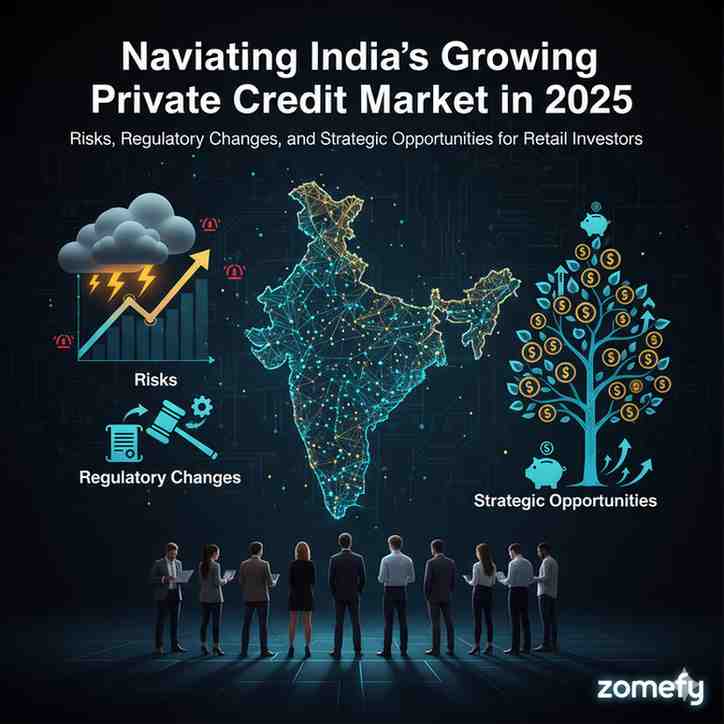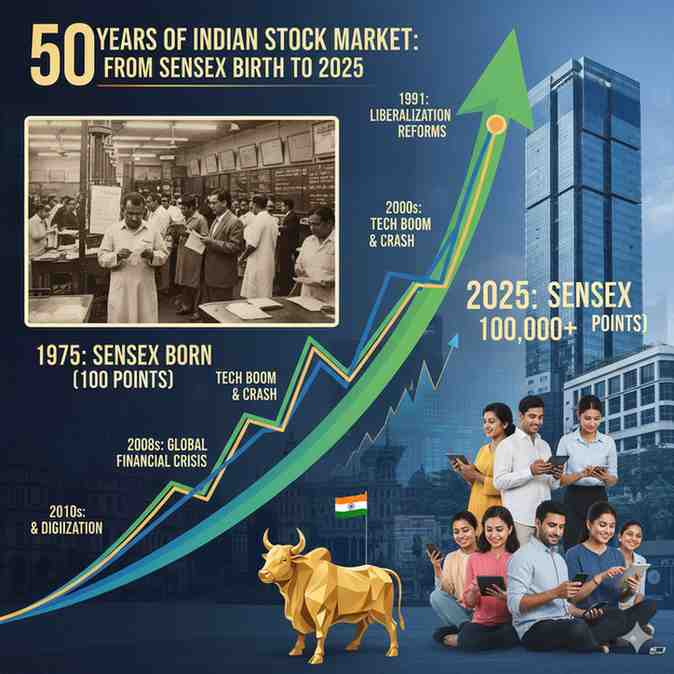India's Economic Pulse 2025: Unraveling GDP Growth, Inflation, and Employment Trends for Informed Investment Decisions
India's economy in 2025 stands at a pivotal juncture, characterized by robust GDP growth, moderated inflation, and evolving employment trends that collectively shape the investment landscape.
India's Economic Pulse 2025: Unraveling GDP Growth, Inflation, and Employment Trends for Informed Investment Decisions
What You Can Do Next
- Read the full article for complete insights
- Save for later reference
- Share with others learning about this topic
Image not available
India's economy in 2025 stands at a pivotal juncture, characterized by robust GDP growth, moderated inflation, and evolving employment trends that collectively shape the investment landscape. With the GDP expanding at an estimated 7.8% year-on-year in Q2 2025, India continues to assert itself as the fastest-growing major economy globally, propelled by strong services sector performance, manufacturing resilience, and structural reforms. Inflation, while contained within the Reserve Bank of India's target range, reflects ongoing global commodity price pressures and domestic demand dynamics. Employment trends indicate a gradual recovery post-pandemic, with particular emphasis on the informal sector and MSMEs, which play a critical role in job creation. This article aims to provide Indian retail investors and financial professionals with a comprehensive analysis of these economic indicators, supported by data-driven insights and practical investment strategies contextualized within India's regulatory and market environment. Understanding these macroeconomic fundamentals is essential for making informed decisions in an increasingly complex and dynamic market.
GDP Growth Dynamics: Momentum and Sectoral Drivers
India's GDP growth in 2025 has exhibited remarkable resilience, expanding by 7.8% year-over-year in Q2, improving from 6.4% in the previous quarter. This acceleration surpasses the IMF's earlier projection of 6.2% for the year and reflects a broad-based recovery led by services and manufacturing. The services sector, including IT, financial services, and telecommunications, remains the primary engine, contributing approximately 54% to India's GDP. Manufacturing growth, supported by government initiatives such as 'Make in India' and production-linked incentives (PLI), has also gained traction, boosting exports and domestic demand.
However, growth is expected to moderate to around 6.5% in 2026 and 5.5% in 2027, reflecting global economic headwinds and domestic challenges such as rural distress and supply chain bottlenecks. Notably, MSMEs, which contribute nearly 30% of GDP and 45% of manufacturing output, remain a focus area for policy support to sustain growth momentum.
Quarter | GDP Growth YoY (%) | Key Drivers |
|---|---|---|
| Q1 FY 2025-26 | 7.8 | Services sector, Private Consumption |
| Q2 FY 2025-26 | 7.8 | Manufacturing, Exports |
| FY 2026 (Projected) | 6.5 | Moderation due to global slowdown |
Investors should prioritize sectors benefiting from government reforms and global demand, such as technology, pharmaceuticals, and renewable energy. Diversification across growth-oriented midcaps and bluechips with strong balance sheets is advisable to manage volatility. Monitoring policy updates on GST reforms and trade agreements, especially the anticipated India-US trade deal, can provide tactical advantages.
Sectoral Performance and Investment Implications
The services sector remains the cornerstone of India's economic growth, with IT giants like TCS and Infosys reporting steady revenue growth of 12-15% annually, driven by digital transformation globally. The financial services sector benefits from rising digital payments and credit penetration, with companies like HDFC Bank and ICICI Bank showing robust asset quality and expanding retail loan books.
Manufacturing growth is buoyed by sectors such as automobiles and electronics. For example, Tata Motors and Maruti Suzuki have reported volume growth of 8-10% in FY 2025, reflecting strong domestic demand and exports. The government's focus on renewable energy has accelerated investments in solar and wind, with companies like Adani Green Energy expanding capacity rapidly.
Sector | Contribution to GDP (%) | Key Companies | 2025 Growth Outlook (%) |
|---|---|---|---|
| Services | 54 | TCS, Infosys, HDFC Bank | 8.0 |
| Manufacturing | 17 | Tata Motors, Maruti Suzuki | 7.0 |
| Agriculture | 16 | NA | 3.5 |
| Renewable Energy | 2 | Adani Green Energy | 15.0 |
Actionable investment strategies include: - Allocating to IT and financial services for stable growth and dividends - Targeting midcap industrials with export exposure - Considering green energy funds and stocks aligned with India’s renewable targets
Risk considerations involve global economic slowdowns impacting exports, regulatory changes, and commodity price volatility affecting input costs.
Inflation Trends and Monetary Policy Outlook
Inflation in India during 2025 has moderated to around 5.3% year-on-year as of mid-year, aligning closely with the Reserve Bank of India's (RBI) target band of 4% ± 2%. Food inflation remains a key driver due to monsoon variability affecting agricultural output, while fuel prices have shown relative stability following global energy market adjustments.
The RBI has adopted a calibrated monetary policy stance, balancing inflation control with growth support. The repo rate currently stands at 6.5%, with the central bank signaling a cautious approach to future hikes amid global uncertainties and domestic demand fluctuations.
Inflation Metric | 2024 Average (%) | 2025 YTD Average (%) | RBI Target Range (%) |
|---|---|---|---|
| Consumer Price Index (CPI) | 6.1 | 5.3 | 4 ± 2 |
| Wholesale Price Index (WPI) | 4.8 | 4.5 | NA |
Inflation's impact on investments manifests through interest rate-sensitive sectors such as real estate, banking, and consumer discretionary. Rising inflation pressures can erode fixed income returns and increase input costs for corporates, impacting profitability.
Investment strategies to hedge inflation risks include: - Increasing allocations in equities with pricing power and export orientation - Considering inflation-indexed bonds and gold ETFs - Avoiding long-duration fixed income instruments prone to rate hikes
Instrument | Inflation Hedge Effectiveness | Pros | Cons |
|---|---|---|---|
| Equities (Exporters, FMCG) | High | Growth potential, dividends | Market volatility |
| Inflation-Indexed Bonds | Medium | Principal protection | Lower liquidity |
| Gold ETFs | High | Safe haven | No income generation |
Investors should track RBI policy statements and inflation data releases closely to adjust portfolios proactively.
Monetary Policy and Interest Rate Expectations
The RBI's monetary policy in 2025 has focused on maintaining a neutral stance, with the repo rate steady at 6.5% since early in the year. Inflation moderation has allowed the central bank to pause rate hikes, supporting credit growth and investment. Liquidity management continues via open market operations and variable reverse repo auctions.
The RBI’s commitment to transparency and forward guidance aids market stability. Analysts project that rates may remain unchanged or see a marginal increase of 25 basis points by Q4 2025 if inflationary pressures resurface.
Policy Rate | Current Level (%) | 2024 Average (%) | Projected End-2025 (%) |
|---|---|---|---|
| Repo Rate | 6.5 | 6.25 | 6.5-6.75 |
| Reverse Repo Rate | 6.0 | 5.75 | 6.0-6.25 |
For investors, this translates to: - Favoring banking stocks with strong net interest margins - Monitoring bond yields for tactical duration management - Watching credit growth data to identify consumption and investment trends
Risks include global monetary tightening by major central banks, which could impact capital flows and exchange rates.
Employment Trends and Labour Market Insights
Employment in India in 2025 is witnessing a steady recovery with the unemployment rate estimated around 6.8%, down from pandemic highs but still elevated relative to pre-pandemic levels. The informal sector, which employs nearly 80% of the workforce, continues to face challenges from automation and structural shifts.
Government initiatives such as the National Employment Policy and Skill India Mission aim to enhance employability and formalize jobs, particularly in tier 2 and tier 3 cities. MSMEs remain crucial, accounting for 45% of total employment and contributing significantly to exports.
Employment Metric | 2023 (%) | 2024 (%) | 2025 (Projected %) |
|---|---|---|---|
| Unemployment Rate | 7.3 | 7.0 | 6.8 |
| Labour Force Participation Rate | 42.5 | 43.0 | 43.5 |
| Formal Sector Employment Growth | 3.2 | 3.5 | 3.8 |
Employment growth is strongest in technology, healthcare, and e-commerce sectors, while traditional sectors face automation-driven job displacement. The rise of the gig economy and digital platforms is creating new employment avenues but also regulatory challenges.
Investment insights include: - Favoring companies with strong human capital management and digital transformation - Considering sectors benefiting from increased consumer spending and urbanization - Monitoring policy changes related to labour laws and social security
Risks entail potential wage inflation and skill mismatches that may impact corporate margins and productivity.
MSME Sector: The Employment Backbone
Micro, Small, and Medium Enterprises (MSMEs) are pivotal to India's employment landscape, employing over 110 million people and contributing nearly 30% to GDP. In 2025, MSMEs face both opportunities and constraints—accelerated digital adoption and government credit schemes have improved access to finance, but challenges remain in productivity and market access.
State-wise MSME performance shows that Maharashtra, Tamil Nadu, and Karnataka lead in contribution and growth, supported by infrastructure and policy incentives. Digitization and GST reforms have helped MSMEs integrate into formal supply chains, enhancing transparency and scalability.
State | MSME Contribution to State GDP (%) | Employment (Million) | Growth Rate (%) |
|---|---|---|---|
| Maharashtra | 18 | 15 | 8.5 |
| Tamil Nadu | 15 | 12 | 7.8 |
| Karnataka | 12 | 10 | 7.0 |
Investment focus areas include: - Financial services targeting MSME credit - Technology platforms enabling MSME digitization - Industrial parks and infrastructure projects supporting MSME clusters
Risks involve regulatory changes, competition from large corporates, and global supply chain disruptions.
Continue Your Investment Journey
Discover more insights that match your interests

Navigating India’s Growing Private Credit Market in 2025: Risks, Regulatory Changes, and Strategic Opportunities for Retail Investors
India’s private credit market is rapidly evolving into a vital component of the country’s financial ecosystem, driven by robust economic growth, structural reforms, and a burgeoning demand for alte...

India’s Commodity Crunch 2025: Decoding Gold, Crude, and Agri Price Trends for Strategic Portfolios
India’s commodity markets are at a pivotal juncture in 2025, shaped by global economic shifts, domestic policy dynamics, and evolving investor behavior.

Zomato 2025: Profitability Pivot — How Foodtech's Marketplace is Reinventing Unit Economics for Investors
Imagine a startup that started as a humble restaurant directory in 2008, battled through years of cash burn and skepticism, and emerged in 2025 as Eternal (formerly Zomato) – a ₹2.

50 Years of Indian Stock Market: From Sensex Birth to 2025 - Complete History
Explore 50 years of Sensex history from 1975 to 2025. Decade-by-decade analysis, major market events, crashes, reforms, and how Indian stock markets evolved into a ₹400 lakh crore powerhouse.
Explore More Insights
Continue your financial education journey
